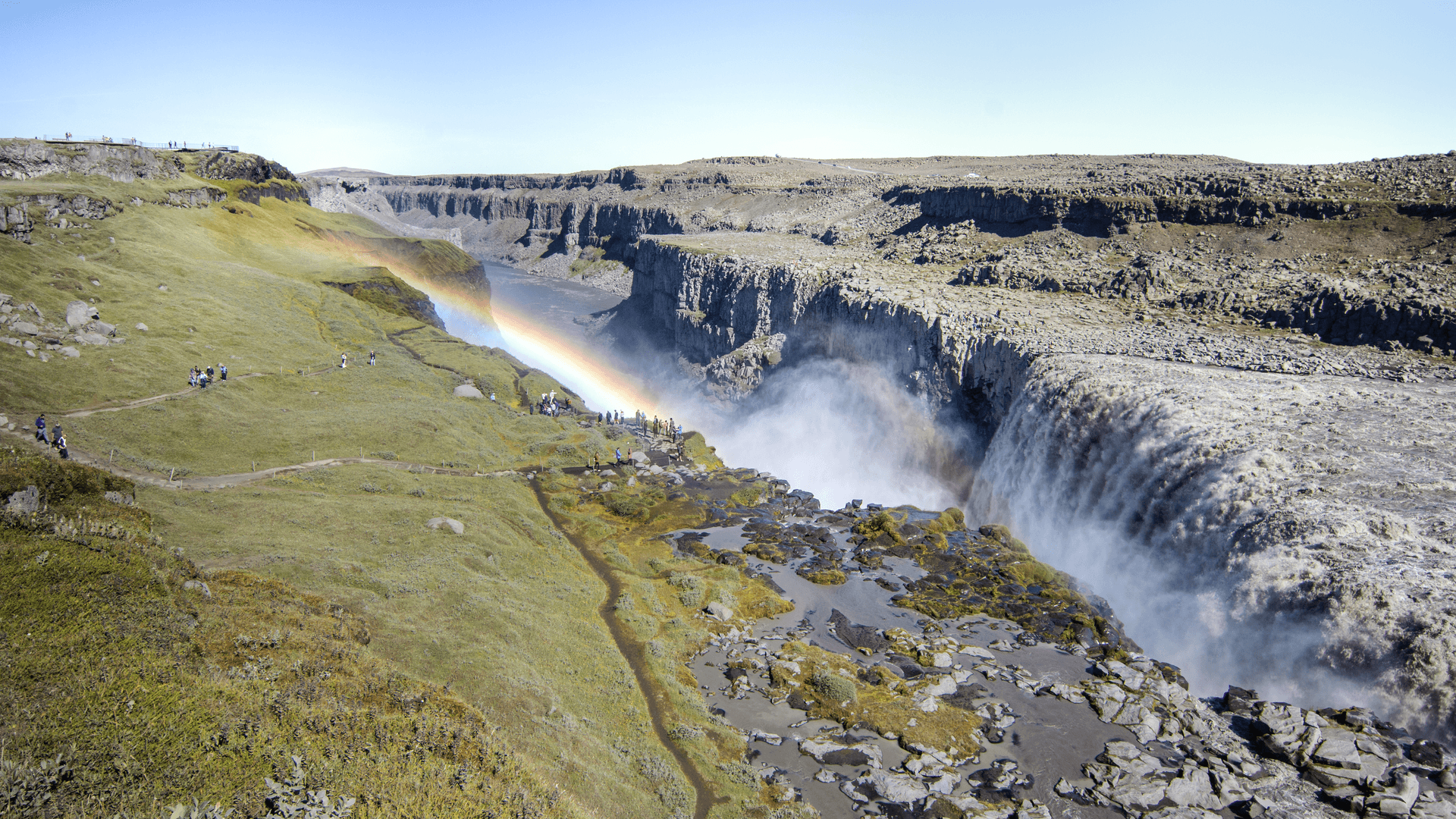You are here
Dettifoss, nicknamed “tumble falls,” is the largest waterfall in Iceland and the most powerful in all of Europe. It spans over 100 meters wide and drops 45 meters (148 feet) into a wide canyon called the Jökulsárglúfur. This is one of many unique features of Vatnajökull National Park and a primary point of interest in the “Diamond Circle” that’s visited by tens of thousands of people each year. It is located in the northeastern region of the country about 50 kilometers from Reykjalið (near Lake Mývatn) and about 150 kilometers from Akureyri. When the sun is shining, there is almost always a rainbow bridging the falls, and if you are visiting on a windy day, prepare to get misted! You can also visit in the winter during frosty periods when heavy piles of ice form over everything in sight. Take extra care while exploring these crumbling edges, and avoid getting close to the lose rocks at the canyon’s rim.
There are viewing areas on both the east and west banks of the river Jökulsá á Fjöllum; however, the eastern route, Hólsfjallavegur F862, is only accessible by four-wheel-drive vehicles during the summer months. Both roads depart from Route N1, the “Ring Road,” and the more popular route (on the west side) is Dettifossvegur, or Route 862. This road goes approximately 25 kilometers to the parking area next to the falls. There is an information stand, a bus stop with schedules, and toilets. The falls is a short walk away, and the paths combine with a network of trails throughout the park that lead to three separate waterfalls; Selfoss, Dettifoss, and Hafragilsfoss.
From the parking area, walk on the marked trail to the first intersection and take a right to the south. This will bring you over a dark sand and water-worn volcanic landscape to Selfoss, the waterfall upstream from Dettifoss. Selfoss spans 70 meters (230 feet) across the canyon and drops about 10 meters (33 feet). Its shape is that of a large horseshoe, and it serves as a nice visual precursor to the much larger Dettifoss shortly downstream. The path here follows the western bank and comes to an end where tourists typically stop exploring and turn around.
Return in the northern direction and keep to the right and east toward the falls which you will undoubtedly hear upon your approach. Climb over a few set of rocks and suddenly Dettifoss will appear before you with its almighty power. Sometimes the crashing water even causes the surrounding bedrock to tremble! Standing in Fosshvammur, a green floral area continuously hydrated by the mist, you will be level with the top of Dettifoss. This waterfall cuts through the canyon at a sharp angle and appears to plunge to into the depths of the earth similar to effect of Gullfoss in the Golden Circle. Dettifoss is nicknamed the “Beast” versus its neighbor the west, Goðafoss, nicknamed “Beauty.” The thunderous amount of water tumbles over the edge at an average rate of 200 cubic meters per second, and during times of heavy rain, this flow can increase to 500 cubic meters per second! (The Norwegian cascade Sarpenfossen has a greater average water flow, but is only about half the height of Dettifoss.) There a several observational platforms to view the falls from and a path, through Fosshvammur, to a high overlook at the northern end. A third waterfall called Hafragilsfoss is about 2 kilometers downstream from Dettifoss: There is a hiking path that leads to it, and it generally isn’t visited by the majority of visitors.
Jökulsá á Fjöllum is one of Iceland’s largest rivers and has its source in Vatnajökull, Iceland’s largest glacier. It extends over 200 kilometers and empties into Öxarfjörður, a bay to the north. These canyons are approximately 25 kilometers long and are a testament to the numerous channels and routes the water has taken over several millennia. In some areas, the cliffs have a measured drop of over 100 meters. Unlike Goðafoss, the water appears grayish and dirty due to the sediment from Vatnajökull. While the entire area seems dry and uninhabitable, there is actually a surprising amount of wildflowers and mosses present throughout the valley.
The area around Jökulsárgljúfur was established as a national park in 1973 and expanded to include Ásbyrgi, to the north, in 1978. The eastern side of the canyon was declared a national monument in 1996, and in 2008 Jökulsárgljúfur became part of Vatnajokull National Park to comprise of all the canyons to the west of Jökulsá. Additional features of the park include Vesturdalur, Hljóðaklettar, Hólmatungur and the huge rock pillars Karl and Kerling (“Old Man” and “Old Woman,” respectively).
There are plenty of opportunities for outdoor recreation amidst the diverse character of the region. Many hiking routes radiate out from the park’s main destinations to explore large basaltic columns, caves, and deep canyons. A 6-kilometer (3.75-miile) hiking path forms a circuit path from Selfoss, to Dettifoss, and a dry side-valley by the rock walls at Sandular, before returning to the parking area from the north. There is also a marked backpacking route between Dettifoss and Ásbyrgi, called Jökulsárhlaup, which is 34kilometers (21 miles) long and takes nearly two days to traverse. The local rangers offer various tours and events, and more information, including marked brochures and maps, can be found at local information centers.
A small designated camping area lies just over a small hill to the north of the bus and caravan parking area. It is very basic with a picnic table and possibly a large jug with water; be prepared with your own equipment.
Science fiction fans may recognize Dettifoss from the film Prometheus (2012), which has the alien standing on a landscape of a primordial Earthlike planet.
Logistics + Planning
Current Weather: Powered by Dark Sky





























Comments
Sign In and share them.